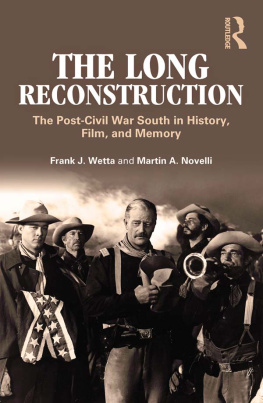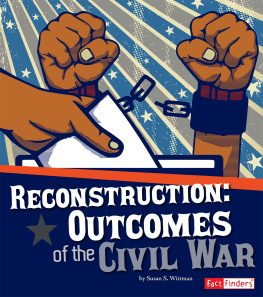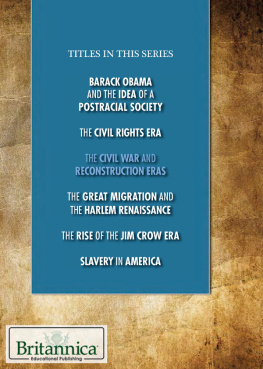The Long Reconstruction
A century and a half after the Civil War, Americans are still dealing with the legacies of the conflict and Reconstruction, including the many myths and legends spawned by these events. The Long Reconstruction: The Post-Civil War South in History, Film, and Memory brings together history and popular culture to explore how the events of this era have been remembered.
Looking at popular cinema across the last hundred years, The Long Reconstruction uncovers central themes in the history of Reconstruction, including violence and terrorism; the experiences of African Americans and those of women and children; the Lost Cause ideology; and the economic reconstruction of the American South.
Analyzing influential films such as The Birth of a Nation and Gone with the Wind, as well as more recent efforts such as Cold Mountain and Lincoln, the authors show how the myths surrounding Reconstruction have impacted American culture.
This engaging book is essential reading for anyone interested in the history of Reconstruction, historical memory, and popular culture.
Frank J. Wetta is Lecturer, Department of History and Senior Fellow, Center for History Politics and Policy, Kean University. He is the author of The Louisiana Scalawags: Politics, Race, and Terrorism during the Civil War and Reconstruction (2012).
Martin A. Novelli is Professor of Film, History, and Humanities at Ocean County College, New Jersey. He also teaches fi lm history at the University of the Arts, Philadelphia.
The Long Reconstruction
The Post-Civil War South in History, Film, and Memory
Frank J. Wetta and
Martin A. Novelli
First published 2014
by Routledge
711 Third Avenue, New York, NY 10017
Simultaneously published in the UK
by Routledge
2 Park Square, Milton Park, Abingdon, Oxon OX14 4RN
Routledge is an imprint of the Taylor & Francis Group, an informa business
2014 Taylor & Francis
The rights of Frank Wetta and Martin Novelli to be identified as the authors of this work has been asserted by them in accordance with sections 77 and 78 of the Copyright, Designs and Patents Act 1988.
All rights reserved. No part of this book may be reprinted or reproduced or utilized in any form or by any electronic, mechanical, or other means, now known or hereafter invented, including photocopying and recording, or in any information storage or retrieval system, without permission in writing from the publishers.
Trademark Notice: Product or corporate names may be trademarks or registered trademarks, and are used only for identification and explanation without intent to infringe.
Library of Congress Cataloging-in-Publication Data
Wetta, Frank Joseph, 1942
The long reconstruction : the post-Civil War south in history, film, and memory / Frank Wetta and Martin Novelli.
pages cm
1. Reconstruction (U.S. history, 18651877)Social aspects. 2. Popular cultureSouthern StatesHistory19th century. 3. United StatesHistoryCivil War, 18611865Motion pictures and the war. 4. Collective memorySouthern States 5. Southern StatesSocial life and customs18656. MemorySocial aspectsSouthern States. 7. United StatesHistoryCivil War, 18611865Infl uence. 8. United StatesHistoryCivil War, 18611865Social aspects. I. Novelli, Martin. II. Title.
E668.W48 2013
973.8dc23
2013010029
ISBN: 978-0-415-89464-7 (hbk)
ISBN: 978-0-415-89465-4 (pbk)
ISBN: 978-0-203-12226-6 (ebk)
Typeset in Sabon
by Apex CoVantage, LLC
For Rachel and Mary
Frank J. Wetta
For my wife Lisa, for my sons Max and Jake,
and for my brother Lawrence
Martin A. Novelli
Contents
The Night They Drove Old Dixie Down:
Constructing Reconstruction History
I Am Vengeful and I Shall Not Sleep:
The Civil War and the Legacy of Violence during Reconstruction
A Gallant Soldier and a Christian Gentleman:
The Reconciliation of North and South
The Civil War and Reconstruction are commonly thought of as occurring in sequencefirst came the war and then Reconstruction. Actually, the war and the struggle over Reconstruction took place simultaneously until 1865. After the Confederate surrender in 1865, the contest over the future of the South continued for at least another twelve years. Some would argue the struggle continued much longerperhaps another hundred years. The chronology below divides this history into distinct phases that marked significant events in the process of Reconstruction. (See The Night They Drove Old Dixie Down: Constructing Reconstruction History.)
I ABRAHAM LINCOLN'S WARTIME
RECONSTRUCTION: 18611865
The process of Reconstruction during Lincoln's presidency was fluid, reflecting the president's belief that his primary duty was to save the Union. He based his Reconstruction policies on his expansive concept of the war powers of the presidency.
| 1861 | August: The First Confiscation Act authorized Federal seizure of any slaves used in support of the rebellion. |
| 1862 | February: Republican Senator Charles Sumner of Massachusetts outlined his state suicide theory. April: With the Southern Democrats gone, a Republican-dominated Congress freed the slaves living in the District of Columbia. June: Congress banned slavery in the territories. Lincoln appointed military governors in Louisiana, Tennessee, and North Carolina. September: Lincoln issued the Preliminary Emancipation Proclamation, hoping that Southern Unionists would take advantage of the opportunity to effect a return to the Union. |
| 1863 | January: Lincoln issued the Emancipation Proclamation. April: The Appalachian region of western Virginia seceded from the rebel state Virginia and joined the Union as a free state. The new state constitution provided for the gradual emancipation of slaves. December: Lincoln, hoping to entice rebels back into the Union, issued the Amnesty and Reconstruction proclamation. He also moved to establish Unionist-based state governments in occupied areas of Louisiana, Arkansas, Virginia, and North Carolina. |
| 1864 | July: Congress passed the Wade-Davis Bill as a protest against Lincoln's plan of Reconstruction. They argued that he was moving too fast. Lincoln responded with a pocket veto. August: Congress reacted to Lincoln's veto with the Wade-Davis Manifesto attacking his Reconstruction policies. November: Lincoln won a second term in office along with Andrew Johnson, a Southern Unionist and pro-war Democrat, as his new vice president. Sherman began his march through Georgia. (Gone with the Wind and Cold Mountain, both novels adapted as motion pictures, provide vivid images of the Southern home front during this period as experienced by white women. See Let's Make a Start: Women and Reconstruction.) |
| 1865 | March: Freedmen's Bureau was established to assist with the transition of the ex-slaves from bondage to freedom. Lincoln's Second Inaugural Address seemed to indicate to many both at the time and afterwards that he favored a quick restoration of the Southern states with limited political reform and humane treatment of the rebels: With malice toward none, with charity for all, with firmness in the right as God gives us to see the right, let us strive on to finish the work we are in, to bind up the nation's wounds, to care for him who shall have borne the battle and for his widow and his orphan, to do all which may achieve and cherish a just and lasting peace among ourselves and with all nations. Andrew Johnson appeared drunk at the inauguration ceremonies. |









